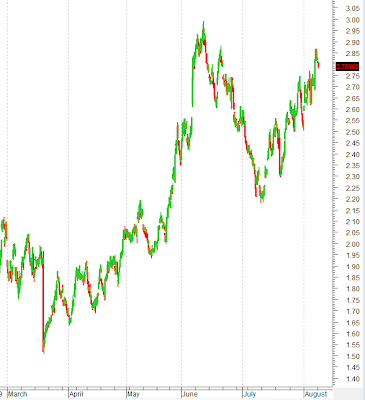Top In The Five Year Treasuries Forming? Is Risk Aversion Returning?
Did Ben Bernanke ever address the dynamic of the entire world trying to stimulate their economies at the same time in his post mortem of the Great Depression and how to prevent a recurrence? Don't think so. Eventually, we will see rates rise and fall based on too much competition for too little capital. In other words, as we have noted repeatedly, globalization is dead and the world is moving to a self-funding economic model. Just because no one is talking about this dynamic doesn't mean it isn't going to happen. It most certainly will. Very bad news for emerging markets and their partners in crime, Wall Street. First we have to watch the stimulating race to the bottom of the barrel play out.
Some financial bloggers have cited the Great Depression as an analogy to show interest rates are going to remain low for decades. Faulty analysis. The U.S. was awash with capital at that time. If the U.S. is not inclined to change the dynamics of globalization or its economic model proactively, they will need to attract capital to run enormous deficits.
The yield on five year Treasuries pressed substantially lower from the stock market peak in June. This was a flight to safety rather than the future debt dynamics we expect to see. Some trading firms obviously saw financial markets were starting to tighten again. Many firms still have ample liquidity so they jammed the shorts off of the July low in equities. This low also corresponded to a low in the five year Treasury rates as well. Obviously a trading dynamic.
It now looks as though the five year market might be setting up for a double top or at least some kind of top with a bearish rising wedge formation off of the July low. Obviously this is anecdotal pattern analysis confirmed by a view of supporting fundamentals including a dollar that has been spiking in the last few days. That chart too looks like a bottoming pattern as the five year appears as a topping pattern.
As we have remarked often, these patterns may or may not resolve themselves in an expected fashion but the dynamics are lining up for a higher probability of some kind of confirmation. Traders often make patterns self-fulfilling when everyone is watching the same pattern develop rather than some underlying force of nature. Although I am confident many of those exist in economics and human behavior as well.
By the way, if we can divine anything from the five year market, we might be inclined to assume most of the risk trade plowed back into equities in late May and early June. It just so happens this was the top in the equity market. In other words, it's quite possible that most money was allocated well too late to take advantage of any equity market upside. And given we are only fifty S&P points higher since then, we might be inclined to worry that there is a lot of money that is going to get fleeced if the market doesn't make substantially higher highs before any type of future economic or financial crises.



<< Home